
The problem addressed is that of picking out the best areas for planting a specific crop within a valley along the north side of the Senegal River at the border between Mauritania and Senegal, two West African nations that front the Atlantic Ocean. The cereal crop is sorghum, a tall grass cultivated in tropical climates that yields grains suited as silage and fodder or, in some varieties, a cane sugarlike juice called sorgo. Many of the factors in the list on the second page of this Section pertaining to agricultural siting apply in this case as well but here we will consider only such key ones as soils types, relief, and periodic flooding (which promotes sorghum growth).
The sequence of steps involved in using GIS to automate the decision
about suitable areas is outlined in this flow chart:

(NOTE: In the graphics that illustrate these steps, the legend created by the Idrisi program is left off, as there is no provision to copy it when the image is converted to a ".tif" format. The color(s) involved in each graphic will be identified in the text as to category.)
The first factor introduced is the elevation variations or relief
. Field surveys have led to a digital elevation model (DEM) data
set from which this general topographic map image (3 meter contour
interval) (DRELIEF in the flow chart is just the file name as
are the others) is produced:
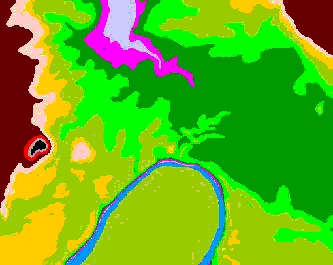
(The sequence of increasing elevations, as color-coded is: blue (lowest, associated with the river; medium gray, purple-red, dark green, medium green, olive, yellow, tan, brown, red, darker gray, black.)
The relief or range of elevations in this scene is 33 meters (about 108 feet), stamping the local region as relatively low. Gentle hills occur in the west and northeast sections. A lowlands extends across the river, with an unusual lower area (a gully?) seen in the north center of the image. This depression controls the localization and retention of water during floods that take place routinely during the rainy season. Flood stages can reach 9 meters (30 ft) above normal stream level.
Using this as a constraint, an image (named FLOOD) that defines
the area of flooding (in blue) is produced through an Idrisi routine
called RECLASS that gives boolean algebra values of 0 and 1 to other ranges
of values. Here, 1 is assigned to all elevation values (in blue) less than
9 (meters), i.e., those prone to flooding, and 0 to all values above this
level (rendered in black in the image).
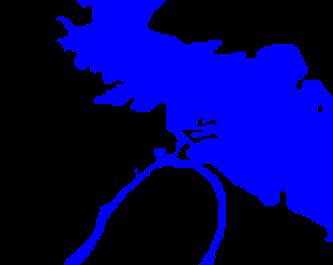
During this stage, the several soil types in the region will differentially
absorb floodwaters such that some retain enough over the long
term to provide a continuing supply of moisture during the growing
season. Thus, soil type becomes another critical factor. Here
is a map (DSOILS) of distribution of five soils within the region:
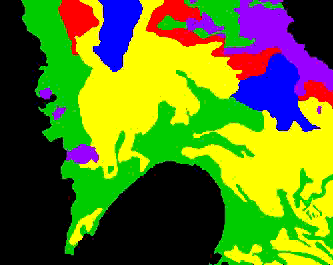
In this map, blue = heavy soils (1); yellow = clays (2); red =
sandy clays (3); green = levee soils (4); purple = stony soils
(5). The Idrisi program allows each soil to be given a suitability
ranking, as follows: best (5) = clays, then in decreasing quality,
levee soils (4), sandy clays (3), heavy clays (2) and worst (1). The black areas are not considered further, for other reasons.
Now the trick becomes that of producing a map (SORGSUIT) in which
the soils are rated by suitability, using the Idrisi ASSIGN program:
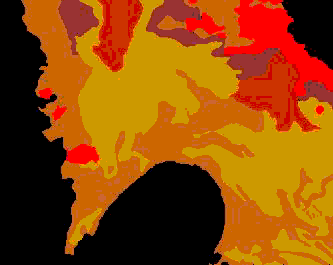
In this map, red = 1 (least suitable); brown = 2; dark brown =
3; yellow brown (most suitable) = 4; black = 5 (not considered). You can
see that this map has the same distribution pattern as the soils
map above but the computer is now instructed to give each soil
a numerical value (an attribute that represents its productiveness
for growing this crop) instead of a soil type name. It is now
a simple matter to generate a map that shows the location and
sizes of patches of clay soil (in green) that constitute the BESTSOIL
for growth:
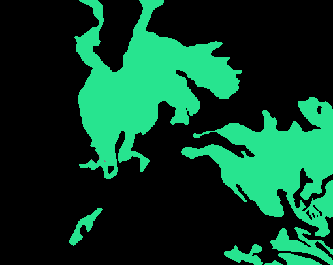
As the flow chart indicates, the final step in the suitability process is to combine the information in the FLOOD and BESTSOIL maps as an OVERLAY to generate a decision end product map called BESTSORG. Again, binary logic using Boolean algebra is required. On each of the intermediate maps, there are just two themes or patterns, one in color and the other black, representing the idea of "good" or "appropriate" (flooded; optimum soil) and "not suitable" respectively. Let "acceptable" = 1, and "not suitable" = 0.
Each data cell (the grid is implicit in the above maps but is
not shown) for each map then has either a 1 or a 0 within it.
Since the two intermediate maps are at the same scale and projection,
they fit or register in the overlay process. The process could
be an analog one, i.e., transparencies of the two maps could be
constructed and visually overlaid on a light table. But, the same
result can be done digitally by combining data in the grid cells
for each map, following this map algebra operation:
| FLOOD | BESTSOIL | BESTSORG | ||
| 0 | X | 0 | = | 0 |
| 0 | X | 1 | = | 0 |
| 1 | X | 0 | = | 0 |
| 1 | X | 1 | = | 1 |
Thus, only those cells that are colored (1) in both maps will
make a product score of 1. These form continuous patches, colored
red, in the BESTSORG map produced by OVERLAY shown here:
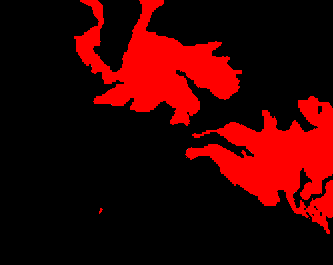
Since the area of each cell is known, the total area associated with suitable conditions is just the product of the number of cells times the unit area. In Idrisi, this is done with the two programs GROUP and AREA.
Of course, many other attributes and thematic factors would be involved in a real suitability case, as for example: Access (roads, etc.), Market Requirements, Fertilizer Needs, Manpower Availability, etc., some of which are expressed as maps and others as data that may be organized into value tables. These can be integrated in GIS models that add to the scores achieved in each data cell. And, as was shown in the Site Suitability illustration presented at the beginning of this page, a different system of ranking could be applied in which a range of rankings, say, from 1 to 10, is associated with each cell (rather than just 0s and 1s), and then summed for all data elements involved.
Code 935, Goddard Space Flight Center, NASA
Written by: Nicholas M. Short, Sr. email: nmshort@epix.net
and
Jon Robinson email: Jon.W.Robinson.1@gsfc.nasa.gov
Webmaster: Bill Dickinson Jr. email: rstwebmaster@gsti.com
Web Production: Christiane Robinson, Terri Ho and Nannette Fekete
Updated: 1999.03.15.